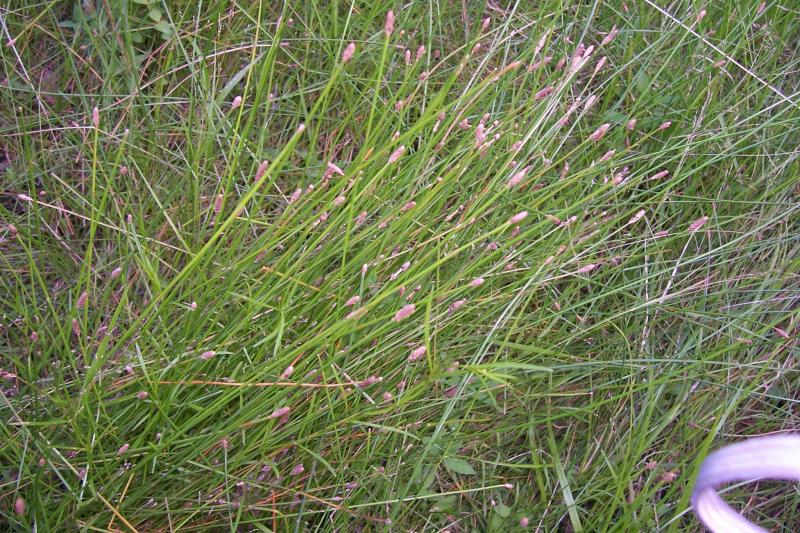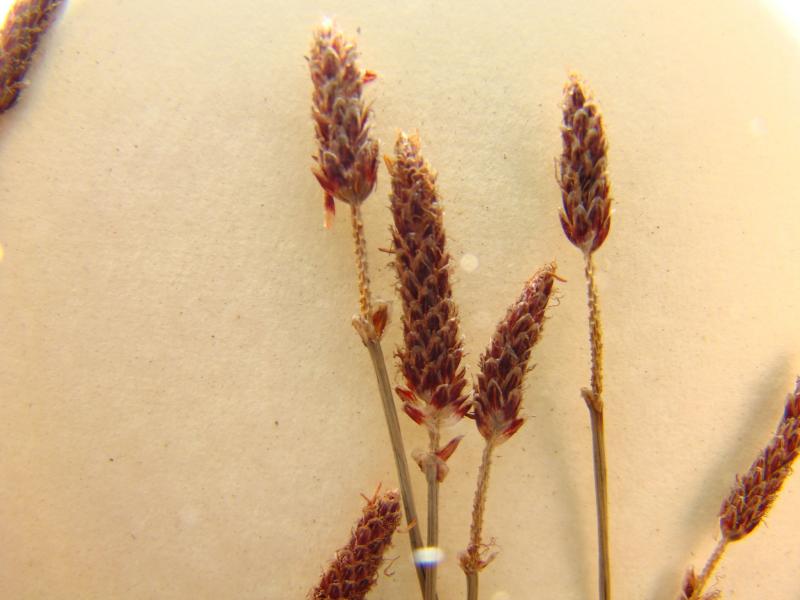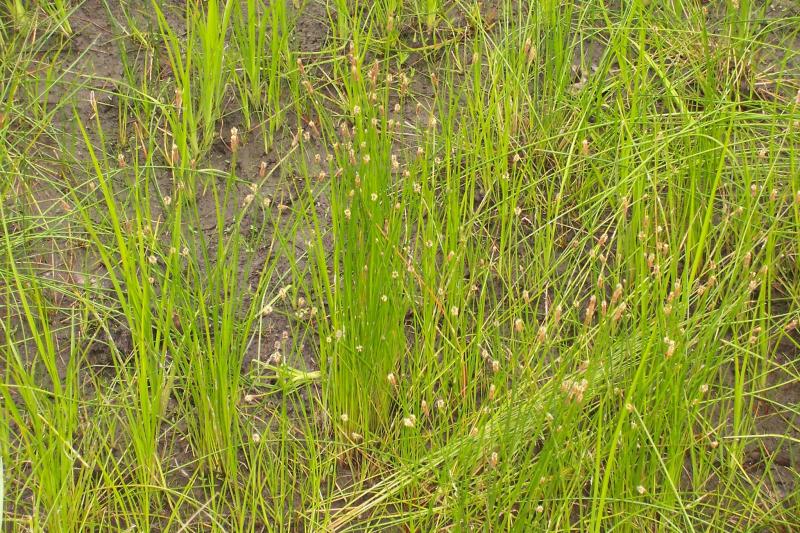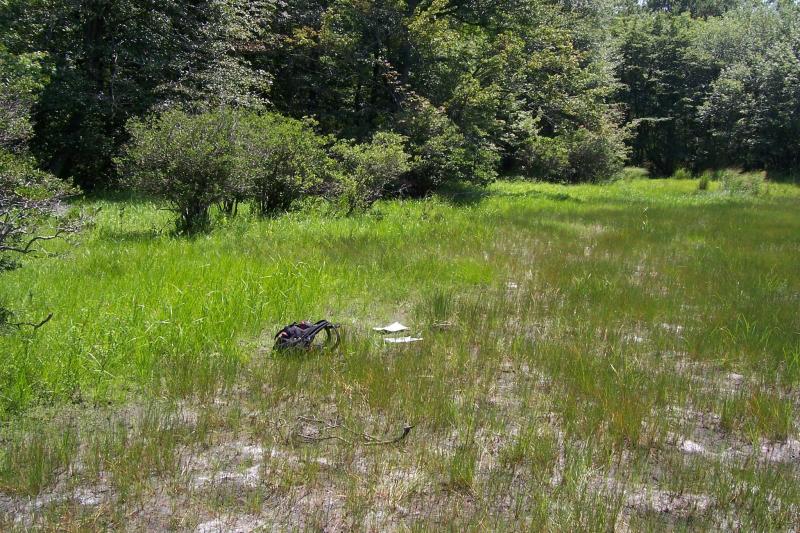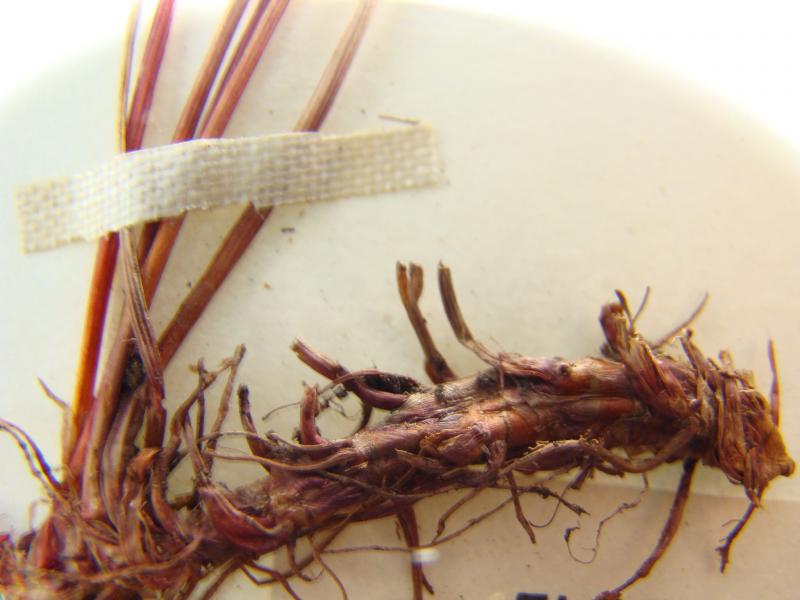Three-ribbed Spike Rush
Eleocharis tricostata Torr.
- Class
- Monocotyledoneae (Monocots)
- Family
- Cyperaceae (Sedge Family)
- State Protection
- Endangered
Listed as Endangered by New York State: in imminent danger of extirpation in New York. For animals, taking, importation, transportation, or possession is prohibited, except under license or permit. For plants, removal or damage without the consent of the landowner is prohibited.
- Federal Protection
- Not Listed
- State Conservation Status Rank
- S1
Critically Imperiled in New York - Especially vulnerable to disappearing from New York due to extreme rarity or other factors; typically 5 or fewer populations or locations in New York, very few individuals, very restricted range, very few remaining acres (or miles of stream), and/or very steep declines.
- Global Conservation Status Rank
- G4
Apparently Secure globally - Uncommon in the world but not rare; usually widespread, but may be rare in some parts of its range; possibly some cause for long-term concern due to declines or other factors.
Summary
Did you know?
The genus name Eleocharis comes from the Greek "elos" for marsh and "charis" for grace. The species name is derived from the 3 sharp angles of the fruit. The germination and growth of this species is very dependent upon water levels in the ponds where it occurs. It may only germinate under flooded conditions. (Zaremba, 2004). This and many other Eleocharis species are important wildlife food for wetland birds and other animals. You can often see damselflies and dragonflies perching on the tops of the stems.
State Ranking Justification
There are six existing populations but three of the sites are surrounded by development and subject to direct human disturbance. Prior to recent survey efforts there were only four historical occurrences known.
Short-term Trends
Surveys in 2006 showed populations to be stable or increasing but populations will fluctuate year-to-year depending on water levels so trends are often hard to evaluate.
Long-term Trends
There were only ever four historical occurrences of this species in the state and we now know of six occurrences in the same general area. As long as the present occurrences continue to be protected long-term future trends appear stable.
Conservation and Management
Threats
The ponds where these plants are found are subject to margin development, filling, and ORV use.
Conservation Strategies and Management Practices
The pondshores need to be protected from direct disturbance by ATVs and excessive trampling. Exotic invasive species must be prevented from colonizing new shoreline areas and present populations must be eliminated. A natural buffer of at least 200 feet should be established around the ponds to prevent excessive runoff and pollution events.
Habitat
Habitat
In New York, Eleocharis tricostata has been found exclusively in open ponds on the coastal plain. Many of these have been within pitch-pine or pine-heath barrens, sometimes at disturbed sites, with exposed sandy or mucky soils (New York Natural Heritage Program 2010). Wet sandy or peaty depressions, pond margins, pine barrens, savannas, mostly coastal plains (FNA 2002). Pine barren ponds (Gleason & Cronquist 1991). Sandy or peaty soil of the coastal plain (Fernald 1970).
Associated Ecological Communities
- Coastal plain pond shore
(guide)
The gently sloping shore of a coastal plain pond with seasonally and annually fluctuating water levels. Plants growing on the pond shore vary with water levels. In dry years when water levels are low there is often a dense growth of annual sedges, grasses, and herbs. Submerged and floating-leaved aquatic plants, such as fragrant waterlily and pondweeds, may become "stranded" on the exposed shore. In wet years when the water level is high only a few emergents and floating-leaved aquatics may be noticeable. T
- Pine barrens vernal pond*
(guide)
A seasonally fluctuating pond and its associated wetlands that typically occurs in pine barrens. The water is intermittent, usually a pond in the spring but sometimes losing water through the summer to become a mostly vegetated wetland at the end of the summer. These ponds and wetlands may be small.
* probable association but not confirmed.
Associated Species
- Agalinis purpurea (purple agalinis)
- Coreopsis rosea (pink coreopsis, pink tickseed)
- Eleocharis flavescens var. olivacea (Torr.) Gleason
- Eleocharis melanocarpa (black-fruited spike-rush)
- Gratiola aurea (golden hedge-hyssop)
- Sagittaria teres (quill-leaved arrowhead)
- Stachys hyssopifolia
- Utricularia gibba (humped bladderwort)
Range
New York State Distribution
All currently known occurrences are in Suffolk County on Long Island. There are historical collections from Suffolk County as well as Westchester County and Seneca County.
Global Distribution
This spikerush occurs along the Atlantic and Gulf coastal plains from Massachusetts and Long Island, where it is rare, south to northern Florida, Georgia, and Alabama. There are a few disjunct inland populations in Seneca County New York and southwestern Michigan. There is an unconfirmed report from northeastern Louisiana.
Identification Comments
General Description
This is a perennial spike rush from a short and stout rhizome. The stems are 2-6 decimeters tall and usually somewhat compressed. The spikelets are cylinder-shaped and 6-16 millimeters long. The flowers have no bristles and the achenes are about 0.6-1 millimeter long, yellow or yellowish-olive with three prominent, sharp, and narrowly-winged angles. The tubercle on the top is acute and nearly flattened and not as wide as the achene.
Best Life Stage for Proper Identification
The best time to identify this spikerush is when it is in fruit.
Similar Species
Eleocharis intermedia is closely related but its flowers have bristles and the angles of the achenes are smooth and not narrowly- winged like E. tricostata.
Best Time to See
The fruits are visible from July through mid-October.
- Fruiting
The time of year you would expect to find Three-ribbed Spike Rush fruiting in New York.
Three-ribbed Spike Rush Images
Taxonomy
Three-ribbed Spike Rush
Eleocharis tricostata Torr.
- Kingdom Plantae
- Phylum Anthophyta
- Class Monocotyledoneae
(Monocots)
- Order Cyperales
- Family Cyperaceae (Sedge Family)
- Order Cyperales
- Class Monocotyledoneae
(Monocots)
- Phylum Anthophyta
Additional Resources
Best Identification Reference
Flora of North America Editorial Committee. 2002. Flora of North America, North of Mexico. Volume 23. Magnoliophyta: Commelinidae (in part): Cyperaceae. Oxford University Press, New York. 608 pp.
Other References
Fernald, M. L. 1950. Gray's manual of botany. 8th edition. Corrected printing (1970). D. Van Nostrand Company, New York. 1632 pp.
Gleason, Henry A. and A. Cronquist. 1991. Manual of Vascular Plants of Northeastern United States and Adjacent Canada. The New York Botanical Garden, Bronx, New York. 910 pp.
Holmgren, Noel. 1998. The Illustrated Companion to Gleason and Cronquist's Manual. Illustrations of the Vascular Plants of Northeastern United States and Adjacent Canada. The New York Botanical Garden, Bronx, New York.
New York Natural Heritage Program. 2010. Biotics database. New York Natural Heritage Program. New York State Department of Environmental Conservation. Albany, NY.
New York Natural Heritage Program. 2024. New York Natural Heritage Program Databases. Albany, NY.
Weldy, T. and D. Werier. 2010. New York flora atlas. [S.M. Landry, K.N. Campbell, and L.D. Mabe (original application development), Florida Center for Community Design and Research http://www.fccdr.usf.edu/. University of South Florida http://www.usf.edu/]. New York Flora Association http://newyork.plantatlas.usf.edu/, Albany, New York
Links
About This Guide
This guide was authored by: Stephen M. Young
Information for this guide was last updated on: September 6, 2012
Please cite this page as:
New York Natural Heritage Program. 2024.
Online Conservation Guide for
Eleocharis tricostata.
Available from: https://guides.nynhp.org/three-ribbed-spike-rush/.
Accessed July 27, 2024.
